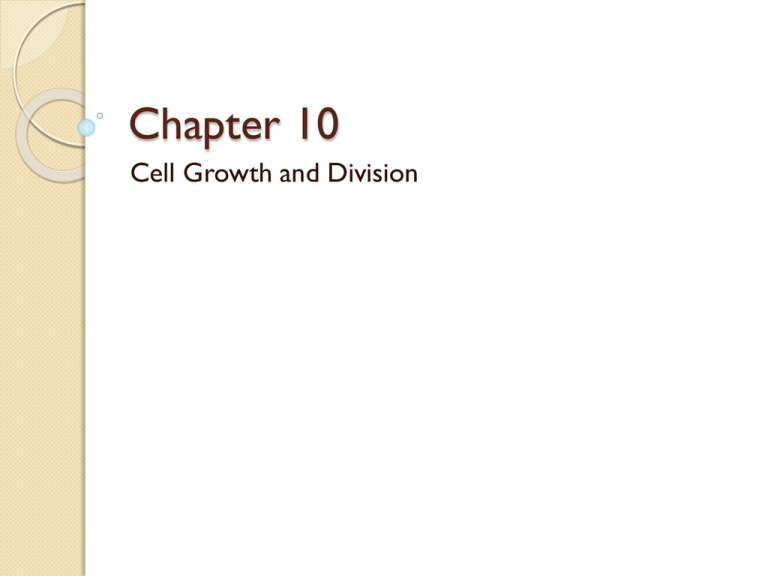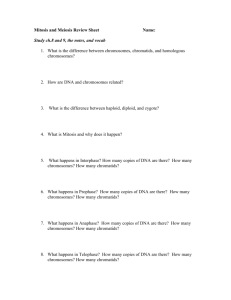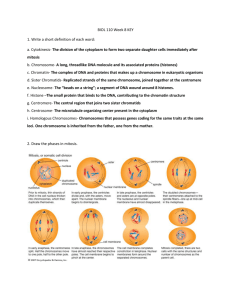Mitosis and meiosis ppt
advertisement

Chapter 10 Cell Growth and Division Why are cells not larger? Cells are small because: 1. DNA “overload” • The larger a cell become, the greater the demand on its DNA; greater need of the resource of DNA 2. Diffusion and osmosis are slow • Rate of exchange depend on surface area 3. Surface area can’t keep up with volume • As cell increases in size, volume increases faster than the surface area • Surface area/Volume ratio How do we overcome this limit to cell size? If we can’t grow by having larger cells, then we must have more cells Cell division is the process by a cell divides into two new daughter cells The cell begins by copying its DNA, each daughter cell gets one copy Cell Division Cell division in prokaryotes is simpler and occurs by binary fission ◦ After DNA replication, cell contents are separated into two parts In eukaryotes cell division occurs by: Mitosis – division of the nucleus Cytokinesis – division of the cytoplasm Some organisms (especially unicellular) reproduce by mitosis and cytokinesis (asexual) Cell division The Forms of DNA DNA is passed down from one generation to the next in the form of Chromosomes (during anaphase and telophase) - precisely compacted chromatin Loose chromatin (during interphase) threads of DNA & some protein Chromatids (during prophase and metaphase) – ½ of a duplicated chromosome ◦ Sister chromatids separate from each other when the cell divides Chromosome Cell Cycle 1. Interphase – when the cell is not dividing, but doing its duty, and perhaps, preparing for division. 2. Mitosis: · Prophase – centrioles separate, spindle forms, paired chromatids, nuclear envelope is breaking apart. · Metaphase – Sister chromatids align on the equator. · Anaphase – Sister chromatids separate and chromosomes move apart. · Telophase – Chromosomes concentrate at ends and nuclear envelopes reform. Cell Cycle Cytokinesis 3. Cytokinesis is the division of the cytoplasm ◦ Typically occurs at the same time as telophase ◦ Animal cells: cell membrane pinches off ◦ Plant cells: cell plate forms midway, gradually developing into a separating membrane Cytokinesis Cell Cycle Cell Division Control Cell growth and cell division are carefully controlled ◦ Cells will grow into open space, but when cells contact other cells they respond by not growing ◦ Controls for cell growth (cell division) can be turned on and off ◦ Similar affect occurs in you injure yourself Cell Division Control Cyclins – proteins that regulate the timing of the cell cycle Many other proteins involved in regulating the cell cycle including internal and external regulators Cancer – uncontrolled cell division. Cancer cells do not respond to the signals that regulate the growth of most cells. Cancer Causes of cancer: 1. Environmental (smoking, UV radiation, viruses…) 2. Genetic (many have a defect in gene p53 which stops the cell cycle until all chromosomes have been properly replicated). Cancer Treatments There is no cure for cancer, and there probably never will be However, there are a number of current and future cancer treatments ◦ Radiation therapy- ionizing radiation designed to kill cancer cells; damages cancer and healthy cells ◦ Chemotherapy- drugs that destroy cancer cells; traditionally affect all rapidly dividing cells Cancer Treatments ◦ Surgery- cut out the cancer cells; is not possible for all cancers ◦ Other treatments- angiogenesis inhibitors, targeted therapies, immunotherapy, electroporation, nanoparticles ◦ Irreversible electroporation Chapter 11 Introduction to Genetics DNA and Sexual Reproduction Why do many organisms combine DNA from two parents to make offspring? How does a sperm and egg (gametes) combine to form 1 cell with appropriate amount of DNA? ◦ If two normal human cells combined to form the new embryo, how much DNA would the embryo have? ◦ How would you overcome this problem? Chromosome Number Humans have 2 pairs of 23 chromosomes (46 total) ◦ 1 set comes from the female, the other from the male parent ◦ The sets are called homologous chromosomes which code for the same trait but are different A cell that has both sets of homologous chromosomes is called diploid (2 sets) A cell (gametes) that only contain 1 set of chromosomes is called haploid (1 set) Meiosis Meiosis is a process of reduction division in which the number of chromosomes per cell is cut in half through the separation of homologous in a diploid cell ◦ Has two distinct sections: Meiosis I and Meiosis II ◦ At the end of Meiosis II, 1 diploid cell has become 4 haploid cells Meiosis I Prior to Meiosis I each chromosome is replicated (like mitosis) ◦ Meiosis I is similar to mitosis ◦ Difference is that in prophase I each chromosome pairs with its corresponding homologous chromosome to form a tetrad ◦ As a result, crossing over occurs which results in exchanging portions of their chromatids Crossing Over Meiosis II After Meiosis I, the two cells enter a second meiotic division (no replication beforehand) ◦ Prophase II, Metaphase II, Anaphase II, Telophase II/ Cytokinesis ◦ Cell now only have half the standard DNA (chromosomes) – haploid ◦ Each of the 4 cells created are unique (genetically different) For males the cell created become sperm, in females an egg (both are gametes) Meiosis







